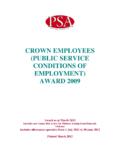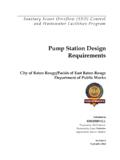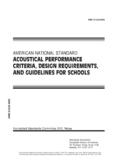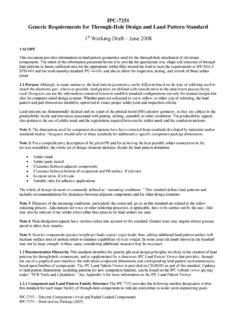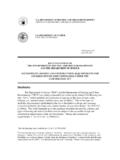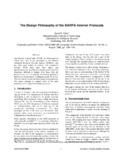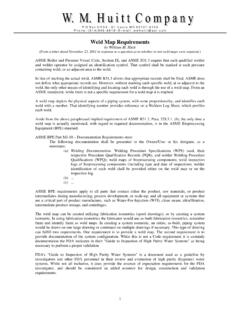Transcription of NSW Government Office Design Requirements ... - …
1 NSW Government Office Design Requirements June 2010 Circulation issue A Guide to workplace Design Requirements for NSW Government Agencies The NSW Government Office Design Requirements were first released in July 1999 as part of the Government s Office Accommodation Reform Program. These revised Office Design Requirements are now a web based tool that will continue to assist agencies to make better decisions about the effective and efficient planning of their Office accommodation. Contents Section One Introduction Foreword Application and use of Office Design Requirements Current Government Policy Premiers Memorandum 2008 06 State Property Authority and Government Property Principles Premier s Memorandum 2008 28 Sustainability Policy for NSW Government Gateway Review System A comment on Office planning Section Two The fundamentals Mandatory Requirements Appropriate space planning models Specific workpoint Design options the kit of parts Team work settings Section Three The fitout process Getting started Building your team Selecting a suitable site Undertaking a needs analysis Communicating with stakeholders Reporting on the project Section Four Reference material Capturing the opportunity for cultural change The role of technology in Office planning Managing the alternative workplace Planning for flexibility
2 Other specialised facilities A word about storage Security and access control Section Five Sustainability Overview Rating Tools and Guides Attachments Diagrams used on website Full sustainability document Section One, Introduction Foreword The NSW Government Office Design Requirements were first released in July 1999 as part of the Government s Office Accommodation Reform Program. These revised Office Design Requirements are now a web based tool that will continue to assist agencies to make better decisions about the effective and efficient planning of their Office accommodation. The way we work has changed substantially over the past 30 40 years. Today we have mobile phones, blackberries, laptop computers, mobile broadband and ever changing technology to help us do our work. We can work where we need to, when we need to. With the exception of entirely new, more recent fitouts, most workplaces tend to be an accumulation of many changes over a number of years to accommodate new demands like additional staff, reorganisations or new initiatives.
3 Generally these workplaces are a poor fit for modern work practices. Today, Office work is more mentally challenging and workplaces need to be able to stimulate minds. Sometimes we need to work in teams and collaborate and other times we need quiet places where we don t get interrupted. We need the technology that supports people in getting the job done without imposing obstacles or nuisances that can be distracting. Work is more dependent on social skills, more reliant on technological skills and much more mobile than it has ever been. Workplace Design needs to be able to support these changes and those that will continue to occur. The workplace should be seen as one of the tools that help an organisation achieve its goals in the most effective and cost efficient manner while also having regard to its impact on the environment. Consider the environmental impacts in your procurement planning when undertaking your fitout project.
4 In addition, workplaces should be planned and designed with sustainability considerations in mind to enable efficient use of resources such as energy, water and fit out material, effective waste recycling and to provide a comfortable and healthy indoor environment for staff during operations. Workplaces today need to be adaptable. They need to accommodate up to three or four different generations of workers with differing expectations of the workplace and differing approaches to work. They also need to be able to respond quickly and cost effectively to change as a result of new projects, new structures or new initiatives. Good workplace Design is important for a number of other reasons including: Recruiting and retaining good staff Supporting productivity gains Achieving results Image Health and safety of staff Reduced impact on the environment The role of the Office in supporting the achievement of corporate goals will continue to evolve.
5 It is now a place where social interaction can occur between staff while still giving them less formal workspaces, touchdown areas, meeting spaces, private areas, meal rooms and the necessary equipment and technology. Section One, Introduction Page | 5 Application and use of the Office Design Requirements The purpose of these Office Design Requirements is to assist Government agencies in ensuring that the workplaces they provide effectively and economically support their service delivery needs and comply with relevant standards and legislation. These Office Design Requirements are to be adopted by all General Government Sector agencies and Public Trading Enterprises (excluding State Owned Corporations). Shareholding Ministers and Boards of State Owned Corporations are to note the Requirements of the Office Design Requirements and encourage their organisations to adopt them as appropriate.
6 The document is divided into a number of sections to allow you to access degrees of detail on the various topics depending on your current knowledge on the subject, or status of your project. The key sections are: Section two The fundamentals This details the essential Requirements that all fitout projects need to meet. The specifics of your particular project will always call for different configurations; however the fundamental Requirements of all projects can be found here. Section three The fitout process This section provides a greater level of detail on the way that a typical project is conducted. Section four Reference material This section contains a series of articles that describe many of the concepts contained within section two, in greater detail putting context to the Requirements Section five Sustainability This section is an executive summary of a separate document that discusses sustainability as it relates to Office Design .
7 Section One, Introduction Page | 6 Premier s Memorandum 2008 06 The State Property Authority and Government Property Principles The State Property Authority has been established by the NSW Government as a corporation with functions relating to the acquisition, management and disposal of Government owned property. The Authority s objectives as stated in the State Property Authority Act 2006 are to: improve operational efficiencies in the use of properties of Government agencies, particularly generic properties (such as offices, warehouses, depots and car parks); manage properties of Government agencies in a way that supports the service delivery functions of those agencies; provide advice and support within Government on property matters; and operate at least as efficiently as any comparable business, consistently with the principles of ecologically sustainable development and social responsibility for the community (including the indigenous community).
8 The Authority is the Government s real estate services provider and is responsible for acquiring and managing Government s generic and, by agreement, other property assets. To assist the State Property Authority to achieve its legislated objectives, the Government has approved a new property policy framework. The framework outlines the relationship between agencies and the State Property Authority in the acquisition, management, maintenance and disposal of property. Key initiatives of the framework are: the immediate vesting (from 1 July 2008) to the State Property Authority of the ownership of all Government owned Office accommodation; the implementation of a commercial rental charge for all Office accommodation vested in the State Property Authority; the transfer to the State Property Authority of management responsibility of all Government leased Office accommodation; the extension of the Government Leasing Service within the State Property Authority to include all lease renewals and new and existing lease negotiations for generic property in the Greater Sydney Metropolitan Area (as defined by the Department of Planning).
9 Regular and ongoing reviews by the State Property Authority of agency property portfolios to identify efficiencies to improve service delivery which will be monitored by the Government Asset Management Committee and reported to Government ; the provision of information by all agencies for the generic property database, including the participation in surveys; review and endorsement of all proposed property acquisitions and disposals by the Government Asset Management Committee; the State Property Authority is Government s preferred acquisition and disposal agency; the State Property Authority will be the lead agency for all multi faceted property proposals that are interlinked by timing, location or use; and the Department of Premier and Cabinet, State Property Authority and NSW Treasury will work cooperatively with Government agencies and relevant unions to address any staffing and funding implications which may arise from implementation of the policy framework.
10 Section One, Introduction Page | 7 The following Government Property Principles outline details of the property policy framework as well as other considerations relating to property title, preferred Office locations, provision of car parking, lease precommitments, sale and lease back proposals and fitout amortisation. Operating Principles Principle 1 All owned Office buildings will be vested in the State Property Authority and lease arrangements will be entered into with tenant agencies through a Memorandum of Understanding. Agencies will not be compensated for the vesting of assets, but will receive budget funding for net rental payments. Normal operating costs will be funded by agencies from existing resources. The vesting of all owned Office buildings will occur from 1 July 2008. Principle 2 Agencies may vest in the Authority any or all of their non generic owned property assets subject to agreement with the Authority and Treasury on resource and funding transfers associated with those properties.
